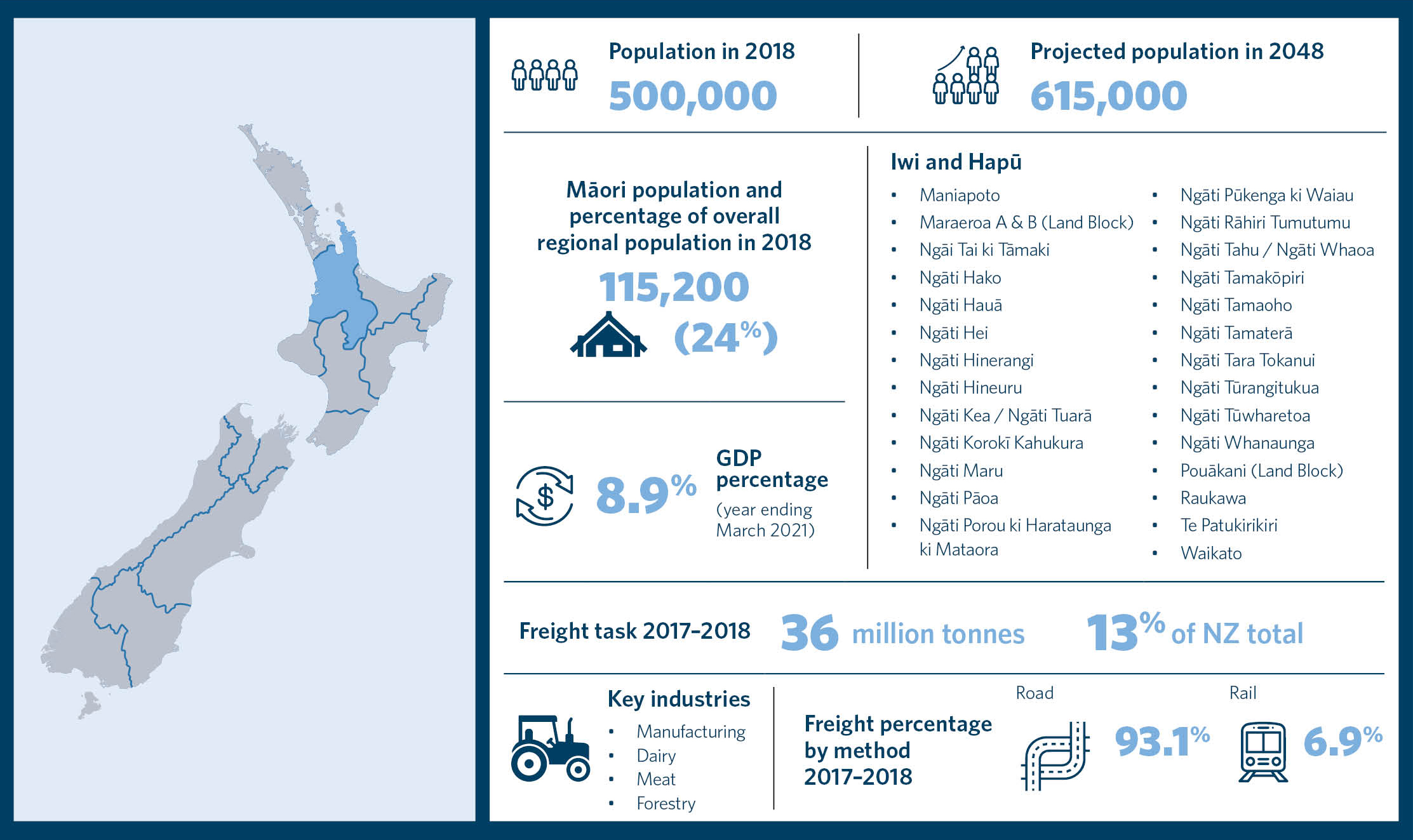At a glance

Arataki Waikato regional direction [PDF, 5.3 MB]
Arataki Waikato statistics table – infographic alternative [PDF, 116 KB]
The September 2023 v1.1 release of Arataki includes updates to reflect the severe weather events of 2023 and make minor corrections. Most sections of the Arataki Waikato regional direction have climate-related updates.
Waikato has the fourth largest regional economy in Aotearoa New Zealand and is nationally important for a range of export-focused primary industries. It sits at the heart of the Upper North Island, with important economic connections to Tāmaki Makaurau Auckland to the north and Te Moana a Toi-te-Huatahi Bay of Plenty to the east. Over the next 30 years, the population of Waikato is expected to grow from about 500,000 to 615,000 by 2048.
The region’s transport network is vital to the country’s economic prosperity, linking people to key destinations and providing important freight access. SH1, SH29, and the East Coast/Main Trunk Lines between Tāmaki Makaurau and Tauranga are among the country’s busiest and most important freight corridors.
The metro area of Kirikiriroa Hamilton is the main urban centre for the region and where the fastest population growth is happening. This area includes the surrounding towns of Kemureti Cambridge, Te Awamutu, Ngāruawāhia, and Mōrena Morrinsville.
The Waikato region, including the metro area of Kirikiriroa, is highly dependent on vehicles. To address this and make progress towards reducing transport emissions, the following will be essential:
- joint spatial planning work
- rollout of high-quality cycling networks
- progressive implementation of aspirational public transport plans.
Focusing our efforts
For efficient and effective progress, transport challenges in Waikato must be tackled in a cohesive way. The directions below identify the most important issues to be resolved over the next 10 years to make progress towards transport outcomes.
- Apply a multi-outcome approach to the delivery of programmes and planning. This includes principles such as fairness, equity, and safety.
- Begin to reduce vehicle kilometres travelled (VKT) in a way that’s fair, equitable, and improves quality of life.
- Enable and support the region’s transition to a low-carbon economy.
- Maintain and improve the resilience and efficiency of interregional connections to the North Island and to the west and east coasts.
- Improve access to social and economic opportunities, especially by public transport, walking, and cycling.
- Significantly reduce the harm caused by the region’s transport system, especially through improved road safety and reduced pollutants that are dangerous to people’s health.
- Use spatial planning work to support, enable, and encourage growth and development into areas that already have good travel choices and shorter average trip lengths.
- Rapidly accelerate the delivery of walking and cycling networks, predominantly through reshaping existing streets, to make these options safe and attractive.
- Implement transport components of the Hamilton Waikato Metro Spatial Plan and integrated transport programme; this includes protecting key corridors plus enabling and accelerating a step-by-step approach to potential future rapid transit corridors over time.
- Continue to improve interregional connectivity for people and freight, especially to Tāmaki Makaurau Auckland, Tauranga, and the Lower North Island; this includes ongoing upgrades to interregional passenger rail between Tāmaki Makaurau and Kirikiriroa Hamilton.
- Explore the potential for new and emerging technologies, such as on-demand services, to improve access to social and economic opportunities.
- Better understand the impact of future economic transformation on travel patterns and freight volumes.
- Explore opportunities to move to a more multi-modal freight system with greater use of rail.
- Confirm how resilience risks will be addressed over time, and work with communities to plan for when to defend, accommodate, or retreat.
- Continue to implement road safety plans and programmes including those focused for iwi Māori.
- Reduce financial and other barriers to iwi Māori getting a driver’s licence in areas not well served by public transport.
- Improve or maintain, as appropriate, physical access to marae, papakāinga, wāhi tapu, and wāhi taonga.
These will be updated over time to focus effort on the most critical matters.
Arataki Waikato regional direction [PDF, 5.3 MB]
